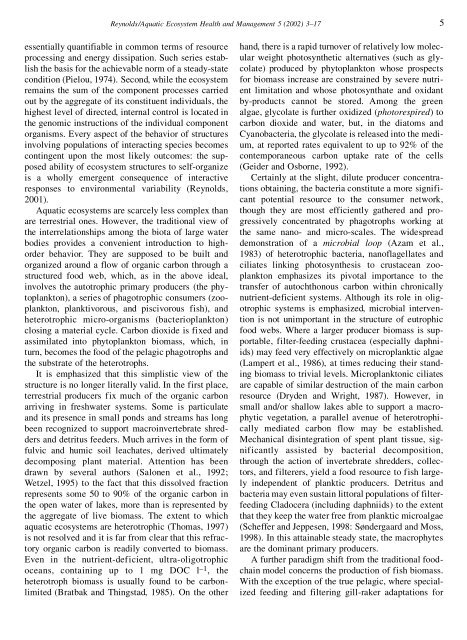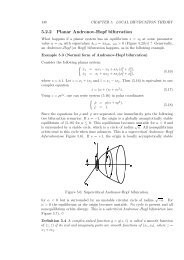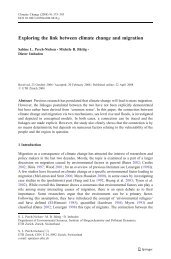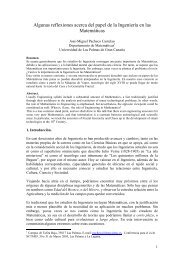Resilience in aquatic ecosystems - hysteresis, homeostasis, and ...
Resilience in aquatic ecosystems - hysteresis, homeostasis, and ...
Resilience in aquatic ecosystems - hysteresis, homeostasis, and ...
You also want an ePaper? Increase the reach of your titles
YUMPU automatically turns print PDFs into web optimized ePapers that Google loves.
Reynolds/Aquatic Ecosystem Health <strong>and</strong> Management 5 (2002) 3–17 5<br />
essentially quantifiable <strong>in</strong> common terms of resource<br />
process<strong>in</strong>g <strong>and</strong> energy dissipation. Such series establish<br />
the basis for the achievable norm of a steady-state<br />
condition (Pielou, 1974). Second, while the ecosystem<br />
rema<strong>in</strong>s the sum of the component processes carried<br />
out by the aggregate of its constituent <strong>in</strong>dividuals, the<br />
highest level of directed, <strong>in</strong>ternal control is located <strong>in</strong><br />
the genomic <strong>in</strong>structions of the <strong>in</strong>dividual component<br />
organisms. Every aspect of the behavior of structures<br />
<strong>in</strong>volv<strong>in</strong>g populations of <strong>in</strong>teract<strong>in</strong>g species becomes<br />
cont<strong>in</strong>gent upon the most likely outcomes: the supposed<br />
ability of ecosystem structures to self-organize<br />
is a wholly emergent consequence of <strong>in</strong>teractive<br />
responses to environmental variability (Reynolds,<br />
2001).<br />
Aquatic <strong>ecosystems</strong> are scarcely less complex than<br />
are terrestrial ones. However, the traditional view of<br />
the <strong>in</strong>terrelationships among the biota of large water<br />
bodies provides a convenient <strong>in</strong>troduction to highorder<br />
behavior. They are supposed to be built <strong>and</strong><br />
organized around a flow of organic carbon through a<br />
structured food web, which, as <strong>in</strong> the above ideal,<br />
<strong>in</strong>volves the autotrophic primary producers (the phytoplankton),<br />
a series of phagotrophic consumers (zooplankton,<br />
planktivorous, <strong>and</strong> piscivorous fish), <strong>and</strong><br />
heterotrophic micro-organisms (bacterioplankton)<br />
clos<strong>in</strong>g a material cycle. Carbon dioxide is fixed <strong>and</strong><br />
assimilated <strong>in</strong>to phytoplankton biomass, which, <strong>in</strong><br />
turn, becomes the food of the pelagic phagotrophs <strong>and</strong><br />
the substrate of the heterotrophs.<br />
It is emphasized that this simplistic view of the<br />
structure is no longer literally valid. In the first place,<br />
terrestrial producers fix much of the organic carbon<br />
arriv<strong>in</strong>g <strong>in</strong> freshwater systems. Some is particulate<br />
<strong>and</strong> its presence <strong>in</strong> small ponds <strong>and</strong> streams has long<br />
been recognized to support macro<strong>in</strong>vertebrate shredders<br />
<strong>and</strong> detritus feeders. Much arrives <strong>in</strong> the form of<br />
fulvic <strong>and</strong> humic soil leachates, derived ultimately<br />
decompos<strong>in</strong>g plant material. Attention has been<br />
drawn by several authors (Salonen et al., 1992;<br />
Wetzel, 1995) to the fact that this dissolved fraction<br />
represents some 50 to 90% of the organic carbon <strong>in</strong><br />
the open water of lakes, more than is represented by<br />
the aggregate of live biomass. The extent to which<br />
<strong>aquatic</strong> <strong>ecosystems</strong> are heterotrophic (Thomas, 1997)<br />
is not resolved <strong>and</strong> it is far from clear that this refractory<br />
organic carbon is readily converted to biomass.<br />
Even <strong>in</strong> the nutrient-deficient, ultra-oligotrophic<br />
oceans, conta<strong>in</strong><strong>in</strong>g up to 1 mg DOC l –1 , the<br />
heterotroph biomass is usually found to be carbonlimited<br />
(Bratbak <strong>and</strong> Th<strong>in</strong>gstad, 1985). On the other<br />
h<strong>and</strong>, there is a rapid turnover of relatively low molecular<br />
weight photosynthetic alternatives (such as glycolate)<br />
produced by phytoplankton whose prospects<br />
for biomass <strong>in</strong>crease are constra<strong>in</strong>ed by severe nutrient<br />
limitation <strong>and</strong> whose photosynthate <strong>and</strong> oxidant<br />
by-products cannot be stored. Among the green<br />
algae, glycolate is further oxidized (photorespired) to<br />
carbon dioxide <strong>and</strong> water, but, <strong>in</strong> the diatoms <strong>and</strong><br />
Cyanobacteria, the glycolate is released <strong>in</strong>to the medium,<br />
at reported rates equivalent to up to 92% of the<br />
contemporaneous carbon uptake rate of the cells<br />
(Geider <strong>and</strong> Osborne, 1992).<br />
Certa<strong>in</strong>ly at the slight, dilute producer concentrations<br />
obta<strong>in</strong><strong>in</strong>g, the bacteria constitute a more significant<br />
potential resource to the consumer network,<br />
though they are most efficiently gathered <strong>and</strong> progressively<br />
concentrated by phagotrophs work<strong>in</strong>g at<br />
the same nano- <strong>and</strong> micro-scales. The widespread<br />
demonstration of a microbial loop (Azam et al.,<br />
1983) of heterotrophic bacteria, nanoflagellates <strong>and</strong><br />
ciliates l<strong>in</strong>k<strong>in</strong>g photosynthesis to crustacean zooplankton<br />
emphasizes its pivotal importance to the<br />
transfer of autochthonous carbon with<strong>in</strong> chronically<br />
nutrient-deficient systems. Although its role <strong>in</strong> oligotrophic<br />
systems is emphasized, microbial <strong>in</strong>tervention<br />
is not unimportant <strong>in</strong> the structure of eutrophic<br />
food webs. Where a larger producer biomass is supportable,<br />
filter-feed<strong>in</strong>g crustacea (especially daphniids)<br />
may feed very effectively on microplanktic algae<br />
(Lampert et al., 1986), at times reduc<strong>in</strong>g their st<strong>and</strong><strong>in</strong>g<br />
biomass to trivial levels. Microplanktonic ciliates<br />
are capable of similar destruction of the ma<strong>in</strong> carbon<br />
resource (Dryden <strong>and</strong> Wright, 1987). However, <strong>in</strong><br />
small <strong>and</strong>/or shallow lakes able to support a macrophytic<br />
vegetation, a parallel avenue of heterotrophically<br />
mediated carbon flow may be established.<br />
Mechanical dis<strong>in</strong>tegration of spent plant tissue, significantly<br />
assisted by bacterial decomposition,<br />
through the action of <strong>in</strong>vertebrate shredders, collectors,<br />
<strong>and</strong> filterers, yield a food resource to fish largely<br />
<strong>in</strong>dependent of planktic producers. Detritus <strong>and</strong><br />
bacteria may even susta<strong>in</strong> littoral populations of filterfeed<strong>in</strong>g<br />
Cladocera (<strong>in</strong>clud<strong>in</strong>g daphniids) to the extent<br />
that they keep the water free from planktic microalgae<br />
(Scheffer <strong>and</strong> Jeppesen, 1998: Søndergaard <strong>and</strong> Moss,<br />
1998). In this atta<strong>in</strong>able steady state, the macrophytes<br />
are the dom<strong>in</strong>ant primary producers.<br />
A further paradigm shift from the traditional foodcha<strong>in</strong><br />
model concerns the production of fish biomass.<br />
With the exception of the true pelagic, where specialized<br />
feed<strong>in</strong>g <strong>and</strong> filter<strong>in</strong>g gill-raker adaptations for






